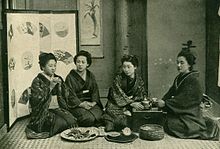 A photograph of Japanese women from the book "Japan And Japanese" (1902) | |
| General Statistics | |
|---|---|
| Maternal mortality (per 100,000) | 5 (2010) |
| Women in parliament | 10.2% (2018)[1] |
| Women over 25 with secondary education | 80.0% (2010) |
| Women in labour force | 64.6% employment rate (2015)[2] |
| Gender Inequality Index[3] | |
| Value | 0.083 (2021) |
| Rank | 22nd out of 191 |
| Global Gender Gap Index[4] | |
| Value | 0.650 (2022) |
| Rank | 116th out of 146 |
| Part of a series on |
| Women in society |
|---|
 |
Although women in Japan were recognized as having equal legal rights to men after World War II, economic conditions for women remain unbalanced.[5] Modern policy initiatives to encourage motherhood and workplace participation have had mixed results.[6]
Women in Japan obtained the right to vote in 1945.[7] While Japanese women's status has steadily improved in the decades since then, traditional expectations for married women and mothers are cited as a barrier to full economic equality.[8] The monarchy is strictly male-only and a princess has to resign her imperial title if she marries a commoner.
- ^ "Women in Parliaments: World Classification". www.ipu.org.
- ^ OECD. "LFS by sex and age - indicators". Stats.oecd.org. Retrieved 2019-08-04.
- ^ "Human Development Report 2021/2022" (PDF). HUMAN DEVELOPMENT REPORTS. Retrieved 18 October 2022.
- ^ "Global Gender Gap Report 2022" (PDF). World Economic Forum. Retrieved 1 March 2023.
- ^ Cite error: The named reference
nytimes-soblewas invoked but never defined (see the help page). - ^ Cite error: The named reference
Borovoywas invoked but never defined (see the help page). - ^ "Birth of the Constitution of Japan - Chronological Table". National Diet Library, Japan. Retrieved 18 February 2020.
- ^ Cite error: The named reference
Noharawas invoked but never defined (see the help page).